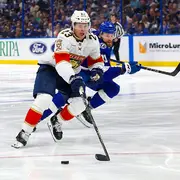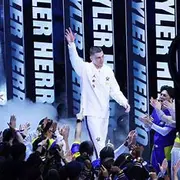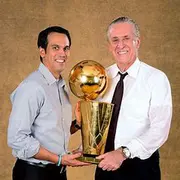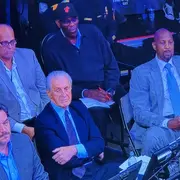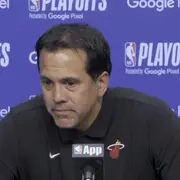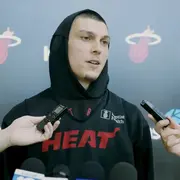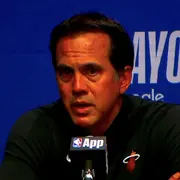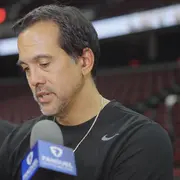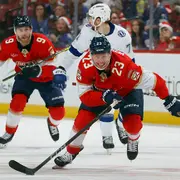From Bubble Breakout to Big Decisions
Tyler Herro first captured the NBA spotlight during the 2020 Bubble Playoffs, where he played beyond his years as a 20-year-old rookie on a title-contending Miami Heat squad. Averaging 16.0 points per game across 21 postseason contests — including a legendary 37-point outburst against Boston in the Eastern Conference Finals — Herro quickly earned a reputation as a fearless shot-maker and rising star. His swagger, scoring ability, and poise on the big stage made him a household name and a core piece of the Heat’s future. But five seasons later, the question lingers: Has Herro grown into the franchise cornerstone Miami hoped for — or simply a really good scorer on a team still searching for its identity?
Contract Details
With a $149.7 million extension on the table this October, the Miami Heat must decide if Tyler Herro is worth a deal that would pay him $50+ million annually through 2030.
Tyler Herro isn’t new to big-money conversations — he already secured a 4-year, $130 million extension from the Heat in 2022, the same offseason Darius Garland landed his five-year, $193 million max rookie extension with Cleveland. At the time, both guards were seen as franchise cornerstones. Now, three years later, Garland’s contract is trending toward value while Herro’s future hangs in the balance — especially with a new deal potentially paying him $50+ million per year starting in 2027-28.
Starting October 1, the Miami Heat can offer Tyler Herro a three-year, $149.7 million contract extension — a deal that would eventually pay the 25-year-old guard $50 million a year. Herro is already locked in for $64 million over the next two seasons, but the question now is whether Pat Riley and the front office believe he’s worth max money through 2031. If no extension is signed by October 20, Herro becomes eligible for an even bigger four-year, $206.9 million extension in the 2026 offseason.
Herro isn’t ducking the conversation.
“Everyone knows I want to be here long term,” Herro said. “I’m excited to see what the organization has to say. We’ll see if they want me here as much as I want to be here.”
On paper, Herro’s case is compelling — an ascending scorer with All-Star flashes and a defined role in Erik Spoelstra’s offense. But for a franchise facing a possible roster shake-up and already burdened with large contracts, the price tag might give them pause.
What the Numbers Say
Data found via Basketball Reference.
Herro just wrapped up a strong 2024-25 campaign, averaging 23.9 points, 5.5 assists, and 5.2 rebounds per game while shooting 47.2% from the field, 37.5% from three, and 87.8% from the free-throw line. It was arguably his most complete season yet — with career highs in scoring, assists, and efficiency.
Herro finished the season top 20 in scoring league-wide and showed growth as a playmaker. His career-best 56.3% effective field goal percentage signals improved shot selection and efficiency — critical traits for a lead guard in a modern offense.
Playoff History and Clutch Performance: Still Room to Grow
Despite his postseason heroics as a rookie in the 2020 Bubble (16.0 PPG in 21 games), Herro’s playoff track record since has been mixed.
While he’s averaged 14.6 points over 50 playoff games, his shooting percentages — particularly from three (32.8%) — have dipped under pressure. That was shown at a premium this season, as Herro was one of the worst performers in the clutch amongst the entire NBA. In the last five minutes of games with the score within five points, he appeared in 35 such contests, averaging just 3.0 minutes per opportunity with a Net Rating of -0.7. His True Shooting Percentage (TS%) in those moments was an alarming 37.0%, and he posted a 31.9% eFG, with a usage rate of 30.9% — suggesting he wasn’t shying away from the moment, but also not converting. For someone commanding a near-max deal, that’s something Miami has to weigh.
Defensive Concerns
Statistical Data found via- CraftedNBA.Com
While Tyler Herro continues to blossom offensively — ranking in the 95th percentile in offensive load, 96th in creation, and 95th in overall CraftedOPM — his defensive impact is still a glaring weakness for the Miami Heat.
Herro posted a Defensive Rating of 112.6 this season, a figure that becomes even more problematic when paired with his 9th percentile CraftedDPM (Defensive Plus-Minus). He struggles to generate defensive events — sitting in just the 19th percentile in deflections, 13th percentile in block rate, and 18th percentile in defensive rebounding. Opponents actively exploit him in pick-and-rolls, and his rDTOV (rotational defensive turnovers forced) of -0.5 ranks in the 12th percentile, suggesting minimal disruption to opposing offenses.
That liability was on full display in Game 1 of Miami’s playoff series against Cleveland. The Cavaliers hunted Herro on switches, forcing him to defend elite scorers and sharp-shooting wings in constant motion. They scored 64 points on the 36 possessions where Herro was targeted, and Ty Jerome — a Sixth Man of the Year finalist — exploded late to seal the win.
Herro’s lack of versatility (34th percentile) and limited rim protection (54th percentile Rim Defense, but -1.2 value) force Erik Spoelstra into a tough dilemma: keep his most dynamic scorer on the floor or close games with stronger defenders.
This also helped the Heat blow numerous leads as they didn’t have a #1 guy to take over late, both on offense and defense. Make a play and then hit a big shot, every night they were trying to find the guy who would step up, a similar theme for the last few seasons (other than playoff Jimmy). Can you pay someone the max value contract if they can’t produce like it?
So How Does Tyler Compare?
But to fairly assess his value, we have to look beyond box scores and examine those most similar to him: Darius Garland, Jamal Murray, Devin Booker, and Anfernee Simons.
Darius Garland signed a near-identical max extension and plays a similar offensive role — a high-usage, shot-creating guard. But what separates Garland is his role as a clear No. 2 option behind Donovan Mitchell, a willing facilitator with elite passing vision and the ability to bend defenses without needing to be a volume scorer. In Cleveland’s system, he’s not expected to carry the entire offensive burden — just play off Mitchell and make others better. That’s a more complementary — and sustainable — usage level than Herro’s high-creation rate suggests.
Jamal Murray, like Herro, is a score-first guard with questionable defense, but the gulf lies in championship pedigree. Murray is a proven playoff riser who has consistently elevated his game alongside Nikola Jokić on the biggest stage. He doesn’t just put up numbers — he wins with them. That’s a level of impact Herro has yet to show in deep postseason runs, where his defensive limitations become more exploitable and his scoring comes with more resistance.
Devin Booker, despite a string of injuries, has cemented himself as one of the league’s premier scorers. He can carry an offense, bend schemes, and create for others. Booker’s usage and skill set are simply more advanced, and he’s shown the ability to toggle between lead guard and off-ball assassin. Herro doesn’t have Booker’s isolation gravity or midrange prowess, nor the size and strength to consistently take on top defensive assignments.
Anfernee Simons, the most apt comparison. Like Herro, Simons is a volume scorer on a non-contending team, often tasked with doing more than he’s truly capable of. Neither is a true No. 1 option, and both may be miscast as franchise centerpieces when their best role is likely as a No. 2 or 3 scorer next to a primary initiator. They both struggle defensively, provide little off-ball impact when not scoring, and operate best in a freedom-first system. The difference? Simons’ $100 million deal is more palatable for his role and output — whereas Herro’s higher price tag demands greater two-way contribution or playoff impact.
- Contract Terms: 4 yr(s) / $100,000,000
- Simons is in a very similar situation, possible trade target, extension decision looming, not a proven #1.
So where does Herro stand?
Herro’s’ looking to get paid like a lead guard, produces like a second option, remains inconsistent in the clutch, and defends like a fringe starter. That financial and on-court identity crisis is the crux of Miami’s dilemma. They can’t build a contender around a guard who needs the ball but doesn’t elevate others or defend. Yet they also can’t maximize Herro unless they minimize his usage and surround him with dominant two-way stars.
- on potential extension during 4/30 Exit interview: “Big deal? Not the biggest deal but I would love to be here. The front office, the organization, I think the city, everyone knows how much I love Miami. I’ve been here since I was 18, 19, I got two kids here, so. This is really home for me. I love being here. Basketball is why I’m here at the end of the day, I want to win and I know how badly this organization and this city wants to win. So, I would love to be here. We’ll see what happens. If it doesn’t get done in October I think we could get it done next summer, just be a little bit higher price. So we’ll see.”
The Max: Still Too Much?
The Miami Heat can offer Tyler Herro a three-year, $149.7 million contract extension as early as October 1st.
If both sides wait until the 2026 offseason, Herro would be eligible for a four-year, $207 million extension.
And if he makes an All-NBA team next season, Herro could even qualify for the supermax — a five-year deal worth up to $380 million.
The question is: should the Heat commit to Herro at those numbers?
Is there a path where a Herro extension works?
He’s only 25, continues to improve, and could grow into a superstar. Yet the longer the Heat wait, the more costly it could be.
The Verdict: Worth the Max?
If Miami wants to extend Herro, it has to come at a reasonable price, one that makes both the Heat and Herro happy.
Tyler Herro won’t have a public fallout like Jimmy Butler did, but that deadline gives the Heat a window to shift their direction — and potentially his future — before the season settles in.
If Miami can package expiring contracts and land a superstar, Herro’s value rises to the level of someone like Darius Garland. But if the front office stands pat and treats Herro as its No. 1 option moving forward, it signals a lack of clear direction — and that’s a concerning outlook for the team’s future.
Yes, Miami can justify a big extension for Herro if they make a significant move, but they’re already paying Bam Adebayo $55 million annually. Without added star power, tying up near-max money in Herro, a player who hasn’t consistently produced in the postseason or on both ends of the court, could hurt the team long term as they would just be “running it back” once again. Herro might want to be the face of the franchise — but Miami needs him to be the foundation, not just the frame.
Tyler Herro isn’t a max player in the traditional sense. He’s not the engine of a championship team, not the go-to closer in crunch time, and not someone who elevates teammates on the defensive end. But at just 25 years old and coming off his best season yet, he’s far too valuable to let walk for nothing.
So, what’s the solution?
If the Heat see Herro as part of the future — but not the future — a compromise extension in the $40–44 million annual range makes the most sense. It’s still a huge payday but gives Miami flexibility to chase a star via trade or free agency. Ideally, the deal would include incentives tied to playoff wins or All-Star appearances, or even a team option, protecting Miami in case Herro plateaus.
That’s saying Herro would be down for this, might be more plausible if Miami lets his contract play out.
If Herro and Miami wait until 2026, his next max offer would rise even higher, and Herro would likely feel disrespected without it. Locking him in now — at a discount — gives the Heat both trade value and financial control, even if they don’t view him as a long-term cornerstone.
But if Miami passes on an extension? Then Herro may become less about “can we win with him?” and more about “how can we use him to get the guy we can win with?”
An interesting decision looms but Miami must make a decision, sooner rather than later.
******
Use the code FIVE at PrizePicks.com for $50 to play fantasy sports.
